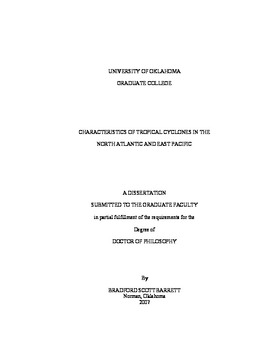| dc.description.abstract | In this dissertation, I present a series of investigations to expand our understanding of TCs in the East Pacific and North Atlantic basins. First, I developed and applied a climatological tool that quickly and succinctly displays the spread of historical TC tracks for any point in the North Atlantic basin. This tool is useful in all parts of a basin because it is derived from prior storm motion trajectories and summarily captures the historical synoptic and mesoscale steering patterns. It displays the strength of the climatological signal and allow for rapid qualitative comparison between historical TC tracks and NWP models. Second, I have used a robust statistical technique to quantify the relationships between fifteen different metrics of TC activity in nine ocean basins and twelve climate indices of the leading modes of atmospheric and oceanic variability. In a thorough, encyclopedic manner, over 12,000 Spearman rank correlation coefficients were calculated and examined to identify relationships between TCs and their environment. This investigation was not limited to the East Pacific or North Atlantic, and new climatic associations were found between seasonal levels of TC activity and the major climate indices across the nine basins. This information is critical to forecasters, economists, actuaries, energy traders, and societal planners who apply knowledge of levels of TC activity on intraseasonal to interdecadal timescales. The statistics are also valuable to climatologists seeking to understand how regional TC frequency will change as the global climate warms. Third, I have examined the leading intraseasonal mode of atmospheric and oceanic variability, the Madden-Julian Oscillation (MJO), and discovered statistically significant relationships with the frequency of TC genesis, intensification, and landfall over the nine basins. Like the significance of the longer-period oscillations to the frequency of TC activity on intraseasonal and longer timescales, these results are highly relevant to the problem of short-term (one- to two-week) predictability of TC activity. These three investigations demonstrate the utility of historical datasets across a wide range of applications, from short-term forecasting to climate studies. In this way, the results highlighted in this dissertation represent a significant and positive contribution to meteorology. Collectively, they reveal multiple characteristics of TCs in the East Pacific and North Atlantic and provide greater understanding of the complex interactions between TCs and their surrounding larger-scale environment. | en_US |
